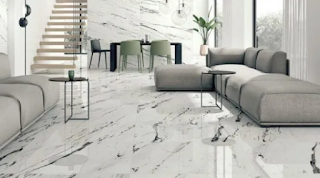MARBLE, LIMESTONE, SLATE & GRANITE
Marble
Marble is the geological name for massive, compact limestone which has been completely re-crystallized by heat and pressure, capturing many foreign substances, thus creating a unique variety of colors and veining (minerals). Marble is simply changed limestone, or to be more specific, metamorphic limestone. The veining which is caused by dissimilarity of materials, often represents areas of weakness within many marbles. Like numerous other stones such as Calcareous stones, travertine and onyx, Marble is also composed chiefly of calcium carbonate.
Marble can be polished and used for architectural and ornamental purposes. Its color varies from white to black, being sometimes yellow, red, and green. Marble is sometimes beautifully veined or clouded. It is preferred for floorings and accentuates the living sphere with its sheer opulence.
Marble stone is relatively softer than other stones and offers less stain resistance. Thus it requires careful maintenance and should be treated as fine furniture. Marble is susceptible to damage from citric acids, alcohols and oils. Spills should be wiped up immediately. Treated properly, marble will remain elegant for decades.
Limestone
Limestone is formed as a result of millions of years of sea shells and bones of sea creatures settling as sediment on an ocean floor (hence it is called a sedimentary stone). The calcium in the bones & shells combines with Carbon Dioxide in the water to form Calcium Carbonate, which is the basic mineral structure of all limestone and marble. Less than 3% of the stone is the color, which is simply other natural elements present when the stone formed (ie iron deposits give you a reddy brown).
It is available in elegant shades of yellow, blue, brown and black. Due to its durability and long-life, limestone is generally used as building stone and for making statues. Its use as wall cladding material has also gained immense popularity.
Slate
Slate is metamorphic rock, like the marble. However, instead of forming from a pre-existing limestone (like marble), slate is formed from the low-grade metamorphism of the sedimentary rock shale and volcanic ash deposited on sea floors. Slate, like shale ("mudstone"), is a very fined-grained rock of mostly microscopic clay minerals with some microscopic quartz and calcite. Slate can also contain some of the same minerals found in granite, which make some slates iridescent and/or hard. The alteration of shale by heat and pressure produces the pronounced partings (slaty cleavage) that give slate its characteristics. Like limestone and marble, the color comes from trace metals. The wild colors on most Chinese and Indian slates are the result of splitting the slate along natural layers, which exposes the metals to the atmosphere, and they oxidize (rust).
Granite
Granite is an igneous rock, which, during its development, remains in the form of liquid magma in the center of the Earth. Unlike lava, granite did not come to the surface. It remained trapped inside the earth where it slowly cooled and crystallized. Due to the extreme pressure within the Earth, and the absence of atmosphere, granite is formed very dense with no pores. Granite is infact a host of ingredients, including common minerals like feldspar, quartz and mica, and the proportions vary considerably from deposit to deposit. The major mineral component of granite is feldspar. Quartz, which is the hardest part of Granite (it ranges from 70% to 80% the density of a diamond) comprises only between 10-30% of the rock, whereas feldspar (potassium and sodium varieties) makes up 60-80%.
Granite comes in various colors varying from stark white to beiges, browns, reds, pinks, yellows, greens, blues, grays and blacks. Textures range from clear to coarse and crystalline to heavily veined. These natural materials were created in the earth many years ago by processes and conditions, which gave each of them varying properties and characteristics.
Granite is the most durable of the stone surfaces, which makes it the best choice for a worry-free countertop. It is extremely durable, stain resistant and easy to care for. It is chip resistant and is unlikely to crack or scratch during normal use.








Comments
Post a Comment